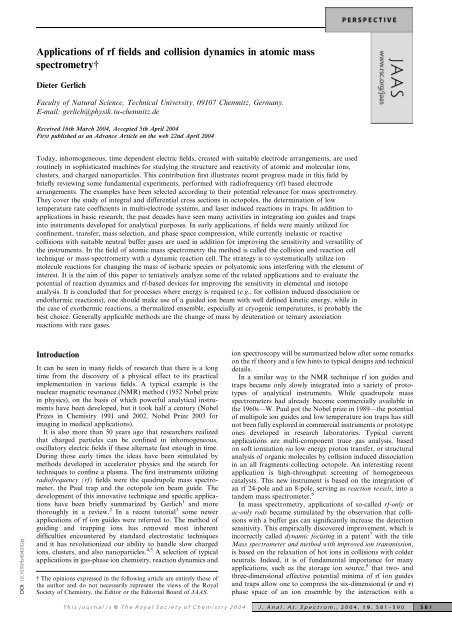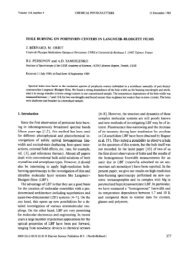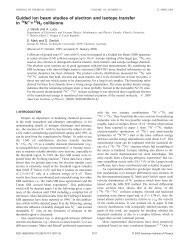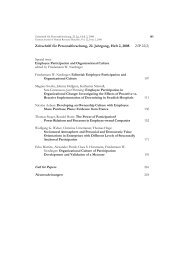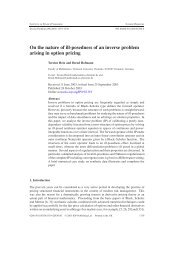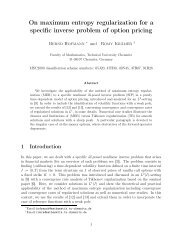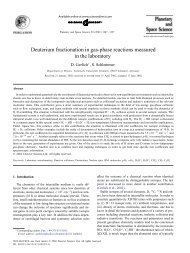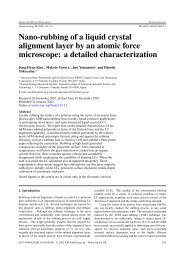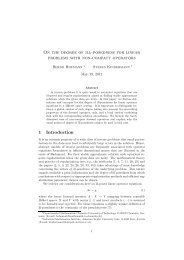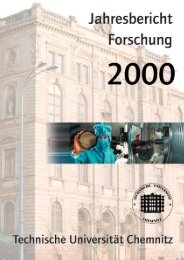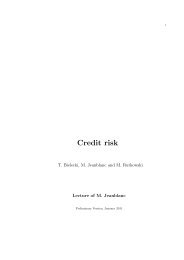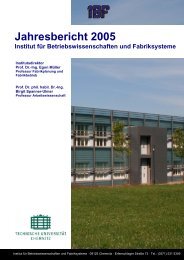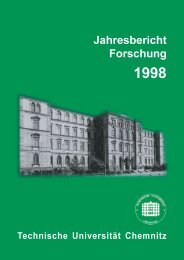Applications of rf fields and collision dynamics in atomic mass ...
Applications of rf fields and collision dynamics in atomic mass ...
Applications of rf fields and collision dynamics in atomic mass ...
Create successful ePaper yourself
Turn your PDF publications into a flip-book with our unique Google optimized e-Paper software.
DOI: 10.1039/b404032p<br />
<strong>Applications</strong> <strong>of</strong> <strong>rf</strong> <strong>fields</strong> <strong>and</strong> <strong>collision</strong> <strong>dynamics</strong> <strong>in</strong> <strong>atomic</strong> <strong>mass</strong><br />
spectrometry{<br />
Dieter Gerlich<br />
Faculty <strong>of</strong> Natural Science, Technical University, 09107 Chemnitz, Germany.<br />
E-mail: gerlich@physik.tu-chemnitz.de<br />
Received 16th March 2004, Accepted 5th April 2004<br />
First published as an Advance Article on the web 22nd April 2004<br />
Today, <strong>in</strong>homogeneous, time dependent electric <strong>fields</strong>, created with suitable electrode arrangements, are used<br />
rout<strong>in</strong>ely <strong>in</strong> sophisticated mach<strong>in</strong>es for study<strong>in</strong>g the structure <strong>and</strong> reactivity <strong>of</strong> <strong>atomic</strong> <strong>and</strong> molecular ions,<br />
clusters, <strong>and</strong> charged nanoparticles. This contribution first illustrates recent progress made <strong>in</strong> this field by<br />
briefly review<strong>in</strong>g some fundamental experiments, pe<strong>rf</strong>ormed with radi<strong>of</strong>requency (<strong>rf</strong>) based electrode<br />
arrangements. The examples have been selected accord<strong>in</strong>g to their potential relevance for <strong>mass</strong> spectrometry.<br />
They cover the study <strong>of</strong> <strong>in</strong>tegral <strong>and</strong> differential cross sections <strong>in</strong> octopoles, the determ<strong>in</strong>ation <strong>of</strong> low<br />
temperature rate coefficients <strong>in</strong> multi-electrode systems, <strong>and</strong> laser <strong>in</strong>duced reactions <strong>in</strong> traps. In addition to<br />
applications <strong>in</strong> basic research, the past decades have seen many activities <strong>in</strong> <strong>in</strong>tegrat<strong>in</strong>g ion guides <strong>and</strong> traps<br />
<strong>in</strong>to <strong>in</strong>struments developed for analytical purposes. In early applications, <strong>rf</strong> <strong>fields</strong> were ma<strong>in</strong>ly utilized for<br />
conf<strong>in</strong>ement, transfer, <strong>mass</strong> selection, <strong>and</strong> phase space compression, while currently <strong>in</strong>elastic or reactive<br />
<strong>collision</strong>s with suitable neutral buffer gases are used <strong>in</strong> addition for improv<strong>in</strong>g the sensitivity <strong>and</strong> versatility <strong>of</strong><br />
the <strong>in</strong>struments. In the field <strong>of</strong> <strong>atomic</strong> <strong>mass</strong> spectrometry the method is called the <strong>collision</strong> <strong>and</strong> reaction cell<br />
technique or <strong>mass</strong> spectrometry with a dynamic reaction cell. The strategy is to systematically utilize ion–<br />
molecule reactions for chang<strong>in</strong>g the <strong>mass</strong> <strong>of</strong> isobaric species or poly<strong>atomic</strong> ions <strong>in</strong>te<strong>rf</strong>er<strong>in</strong>g with the element <strong>of</strong><br />
<strong>in</strong>terest. It is the aim <strong>of</strong> this paper to tentatively analyze some <strong>of</strong> the related applications <strong>and</strong> to evaluate the<br />
potential <strong>of</strong> reaction <strong>dynamics</strong> <strong>and</strong> <strong>rf</strong>-based devices for improv<strong>in</strong>g the sensitivity <strong>in</strong> elemental <strong>and</strong> isotope<br />
analysis. It is concluded that for processes where energy is required (e.g., for <strong>collision</strong> <strong>in</strong>duced dissociation or<br />
endothermic reactions), one should make use <strong>of</strong> a guided ion beam with well def<strong>in</strong>ed k<strong>in</strong>etic energy, while <strong>in</strong><br />
the case <strong>of</strong> exothermic reactions, a thermalized ensemble, especially at cryogenic temperatures, is probably the<br />
best choice. Generally applicable methods are the change <strong>of</strong> <strong>mass</strong> by deuteration or ternary association<br />
reactions with rare gases.<br />
Introduction<br />
It can be seen <strong>in</strong> many <strong>fields</strong> <strong>of</strong> research that there is a long<br />
time from the discovery <strong>of</strong> a physical effect to its practical<br />
implementation <strong>in</strong> various <strong>fields</strong>. A typical example is the<br />
nuclear magnetic resonance (NMR) method (1952 Nobel prize<br />
<strong>in</strong> physics), on the basis <strong>of</strong> which powe<strong>rf</strong>ul analytical <strong>in</strong>struments<br />
have been developed, but it took half a century (Nobel<br />
Prizes <strong>in</strong> Chemistry 1991 <strong>and</strong> 2002, Nobel Prize 2003 for<br />
imag<strong>in</strong>g <strong>in</strong> medical applications).<br />
It is also more than 50 years ago that researchers realized<br />
that charged particles can be conf<strong>in</strong>ed <strong>in</strong> <strong>in</strong>homogeneous,<br />
oscillatory electric <strong>fields</strong> if these alternate fast enough <strong>in</strong> time.<br />
Dur<strong>in</strong>g those early times the ideas have been stimulated by<br />
methods developed <strong>in</strong> accelerator physics <strong>and</strong> the search for<br />
techniques to conf<strong>in</strong>e a plasma. The first <strong>in</strong>struments utiliz<strong>in</strong>g<br />
radi<strong>of</strong>requency (<strong>rf</strong>) <strong>fields</strong> were the quadrupole <strong>mass</strong> spectrometer,<br />
the Paul trap <strong>and</strong> the octopole ion beam guide. The<br />
development <strong>of</strong> this <strong>in</strong>novative technique <strong>and</strong> specific applications<br />
have been briefly summarized by Gerlich 1 <strong>and</strong> more<br />
thoroughly <strong>in</strong> a review. 2 In a recent tutorial 3 some newer<br />
applications <strong>of</strong> <strong>rf</strong> ion guides were referred to. The method <strong>of</strong><br />
guid<strong>in</strong>g <strong>and</strong> trapp<strong>in</strong>g ions has removed most <strong>in</strong>herent<br />
difficulties encountered by st<strong>and</strong>ard electrostatic techniques<br />
<strong>and</strong> it has revolutionized our ability to h<strong>and</strong>le slow charged<br />
ions, clusters, <strong>and</strong> also nanoparticles. 4,5 A selection <strong>of</strong> typical<br />
applications <strong>in</strong> gas-phase ion chemistry, reaction <strong>dynamics</strong> <strong>and</strong><br />
{ The op<strong>in</strong>ions expressed <strong>in</strong> the follow<strong>in</strong>g article are entirely those <strong>of</strong><br />
the author <strong>and</strong> do not necessarily represent the views <strong>of</strong> the Royal<br />
Society <strong>of</strong> Chemistry, the Editor or the Editorial Board <strong>of</strong> JAAS.<br />
This journal is ß The Royal Society <strong>of</strong> Chemistry 2004<br />
ion spectroscopy will be summarized below after some remarks<br />
on the <strong>rf</strong> theory <strong>and</strong> a few h<strong>in</strong>ts to typical designs <strong>and</strong> technical<br />
details.<br />
In a similar way to the NMR technique <strong>rf</strong> ion guides <strong>and</strong><br />
traps became only slowly <strong>in</strong>tegrated <strong>in</strong>to a variety <strong>of</strong> prototypes<br />
<strong>of</strong> analytical <strong>in</strong>struments. While quadrupole <strong>mass</strong><br />
spectrometers had already become commercially available <strong>in</strong><br />
the 1960s—W. Paul got the Nobel prize <strong>in</strong> 1989—the potential<br />
<strong>of</strong> multipole ion guides <strong>and</strong> low temperature ion traps has still<br />
not been fully explored <strong>in</strong> commercial <strong>in</strong>struments or prototype<br />
ones developed <strong>in</strong> research laboratories. Typical current<br />
applications are multi-component trace gas analysis, based<br />
on s<strong>of</strong>t ionization via low energy proton transfer, or structural<br />
analysis <strong>of</strong> organic molecules by <strong>collision</strong> <strong>in</strong>duced dissociation<br />
<strong>in</strong> an all fragments collect<strong>in</strong>g octopole. An <strong>in</strong>terest<strong>in</strong>g recent<br />
application is high-throughput screen<strong>in</strong>g <strong>of</strong> homogeneous<br />
catalysts. This new <strong>in</strong>strument is based on the <strong>in</strong>tegration <strong>of</strong><br />
an <strong>rf</strong> 24-pole <strong>and</strong> an 8-pole, serv<strong>in</strong>g as reaction vessels, <strong>in</strong>to a<br />
t<strong>and</strong>em <strong>mass</strong> spectrometer. 6<br />
In <strong>mass</strong> spectrometry, applications <strong>of</strong> so-called <strong>rf</strong>-only or<br />
ac-only rods became stimulated by the observation that <strong>collision</strong>s<br />
with a buffer gas can significantly <strong>in</strong>crease the detection<br />
sensitivity. This empirically discovered improvement, which is<br />
<strong>in</strong>correctly called dynamic focus<strong>in</strong>g <strong>in</strong> a patent 7 with the title<br />
Mass spectrometer <strong>and</strong> method with improved ion transmission,<br />
is based on the relaxation <strong>of</strong> hot ions <strong>in</strong> <strong>collision</strong>s with colder<br />
neutrals. Indeed, it is <strong>of</strong> fundamental importance for many<br />
applications, such as the storage ion source, 8 that two- <strong>and</strong><br />
three-dimensional effective potential m<strong>in</strong>ima <strong>of</strong> <strong>rf</strong> ion guides<br />
<strong>and</strong> traps allow one to compress the six-dimensional (r <strong>and</strong> v)<br />
phase space <strong>of</strong> an ion ensemble by the <strong>in</strong>teraction with a<br />
J. Anal. At. Spectrom., 2004, 19, 581–590 581
suitable target. Note that focus<strong>in</strong>g or conf<strong>in</strong>ement with electrostatic<br />
ion optics is restricted by the Liouville theorem <strong>and</strong> that<br />
<strong>collision</strong>s <strong>in</strong> general lead to a dispersion <strong>of</strong> the beam.<br />
Besides the cool<strong>in</strong>g <strong>of</strong> the ions created <strong>in</strong> a suitable ion<br />
source, there are various strategies <strong>in</strong> <strong>mass</strong> spectrometry to<br />
obta<strong>in</strong>, <strong>in</strong> addition to the <strong>mass</strong>, structural <strong>in</strong>formation on<br />
molecular ions or reduction <strong>of</strong> disturb<strong>in</strong>g <strong>mass</strong> overlap <strong>in</strong><br />
elemental <strong>and</strong> isotope analysis. In the case <strong>of</strong> <strong>in</strong>ductively<br />
coupled plasma <strong>mass</strong> spectrometers (ICP-MS) spectral <strong>in</strong>te<strong>rf</strong>erences<br />
are reduced by the so-called <strong>collision</strong> <strong>and</strong> reaction cell<br />
(CRC) or the dynamic reaction cell (DRC) technique. 9 In both<br />
<strong>in</strong>struments the ion beam is, prior to the analyzer quadrupole,<br />
guided <strong>in</strong> an <strong>rf</strong>-driven multipole through a reaction chamber<br />
conta<strong>in</strong><strong>in</strong>g an appropriate target gas. In this region, ion–<br />
molecule reactions take place under more or less controlled<br />
conditions <strong>and</strong> they are used to overcome isobaric overlap.<br />
Many tests, 10–12 have shown that the specific design <strong>of</strong> the <strong>rf</strong><br />
ion guide <strong>and</strong> its operat<strong>in</strong>g conditions significantly affect the<br />
efficiency <strong>of</strong> this chemical filter. However, it is questionable<br />
whether the empirically found recipes are optimal or whether<br />
there are better strategies <strong>in</strong> choos<strong>in</strong>g the proper <strong>rf</strong> device,<br />
select<strong>in</strong>g the best operational parameters <strong>and</strong>, an almost hopeless<br />
task, mak<strong>in</strong>g the most favorable use <strong>of</strong> expertise collected<br />
<strong>in</strong> ion–molecule chemistry. It is the aim <strong>of</strong> this contribution to<br />
help to <strong>in</strong>corporate <strong>in</strong>to the DRC <strong>and</strong> CRC techniques our<br />
knowledge <strong>of</strong> the development <strong>and</strong> applications <strong>of</strong> <strong>rf</strong> based<br />
modules <strong>and</strong> <strong>in</strong>struments <strong>and</strong> to make some–maybe somewhat<br />
speculative—proposals orig<strong>in</strong>at<strong>in</strong>g from our experience <strong>in</strong> ion–<br />
molecule reaction <strong>dynamics</strong>, laser <strong>in</strong>duced ion processes <strong>and</strong><br />
low temperature astrochemistry.<br />
Rf <strong>fields</strong>: the need to know<br />
Basic theory<br />
In order to systematically pr<strong>of</strong>it from the features <strong>of</strong> ion guides<br />
<strong>and</strong> traps <strong>and</strong> to make dedicated use <strong>of</strong> ion <strong>dynamics</strong> <strong>in</strong> such<br />
systems, one first needs to underst<strong>and</strong> the motion <strong>of</strong> a particle<br />
under the <strong>in</strong>fluence <strong>of</strong> a time dependent force. Some basics can<br />
be found <strong>in</strong> text-books <strong>of</strong> classical mechanics; 13 however, one<br />
should also be aware that the exact motion <strong>of</strong> charged particles<br />
<strong>in</strong> an arbitrary time dependent electromagnetic field is an<br />
unsolved challeng<strong>in</strong>g problem <strong>of</strong> classical <strong>dynamics</strong>. The <strong>in</strong>clusion<br />
<strong>of</strong> dissipative forces, e.g., by <strong>in</strong>elastic <strong>collision</strong>s, adds to the<br />
mathematical complexity. Many details <strong>of</strong> the basic theory,<br />
numerical calculations <strong>and</strong> a lot <strong>of</strong> experimental tests have been<br />
thoroughly reviewed by Gerlich. 2 In order to make this contribution<br />
not too lengthy we refer <strong>of</strong>ten directly to the figures<br />
<strong>and</strong> formulae <strong>in</strong> this paper. With<strong>in</strong> the last decade a lot <strong>of</strong><br />
additional work has been done, some <strong>of</strong> which has been<br />
summarized by Gerlich 3,5,14 <strong>and</strong> by Armentrout. 15 In the<br />
follow<strong>in</strong>g paper, only a few special h<strong>in</strong>ts are given.<br />
In most applications relevant to <strong>mass</strong> spectrometry, one uses<br />
an <strong>in</strong>homogeneous electric field, E0(r) cos(Vt), which oscillates<br />
<strong>in</strong> time with the frequency V, while the spatial dependence,<br />
E0(r), is given by the boundary conditions imposed by suitable<br />
electrodes. Note that also nodal po<strong>in</strong>ts or l<strong>in</strong>es <strong>of</strong> st<strong>and</strong><strong>in</strong>g or<br />
travell<strong>in</strong>g electromagnetic waves can be <strong>of</strong> practical <strong>in</strong>terest. It<br />
is straightforward to write down the classical equation <strong>of</strong><br />
motion <strong>of</strong> a particle with <strong>mass</strong> m <strong>and</strong> charge q mov<strong>in</strong>g <strong>in</strong> this<br />
field. This differential equation can be solved if the field is<br />
homogeneous: <strong>in</strong> most other situations there are no exact<br />
analytical solutions. One well-know exception is quadrupolar<br />
<strong>fields</strong> (Mathieu equation), but a less-known special case with<br />
an analytical solution is the motion <strong>of</strong> an electron <strong>in</strong> a st<strong>and</strong><strong>in</strong>g<br />
plane electromagnetic wave with circular polarization.<br />
Computer simulations as shown <strong>in</strong> Fig. 1 are very useful for<br />
gett<strong>in</strong>g some feel<strong>in</strong>g for specific properties <strong>of</strong> certa<strong>in</strong> field<br />
geometries <strong>and</strong> for test<strong>in</strong>g dependences on various parameters;<br />
582 J. Anal. At. Spectrom., 2004, 19, 581–590<br />
Fig. 1 Characteristic ion trajectories, illustrat<strong>in</strong>g the transverse<br />
motion <strong>of</strong> an ion <strong>in</strong> an octopole. It can be seen that the trajectory<br />
can be composed <strong>of</strong> a smooth part r0(t) <strong>and</strong> an oscillat<strong>in</strong>g part.<br />
Inspection <strong>of</strong> the direction <strong>of</strong> the wiggl<strong>in</strong>g motion <strong>in</strong> the turn<strong>in</strong>g regions<br />
allows one to deduce the location <strong>of</strong> the electrodes (not shown). Two<br />
different <strong>in</strong>itial conditions have been chosen <strong>in</strong> order to <strong>in</strong>dicate that<br />
not only the k<strong>in</strong>etic energy is conserved <strong>in</strong> average (outer limitation),<br />
but also the orbital angular momentum. Without <strong>collision</strong>s the ion<br />
never reaches the empty <strong>in</strong>ner part. The trajectories <strong>in</strong> the lower panel<br />
<strong>in</strong>dicate the axial motion <strong>in</strong> an octopole. The angle <strong>of</strong> a trajectory<br />
relative to the axis is conserved (reflection law). This is, among others,<br />
important for measur<strong>in</strong>g differential cross sections with the GIB<br />
method. 25,27<br />
however, <strong>in</strong> order to get a deeper <strong>in</strong>sight, analytical approximations<br />
have the advantage that they are more general.<br />
An important criterion for describ<strong>in</strong>g motions such as those<br />
shown <strong>in</strong> Fig. 1 is to search, <strong>in</strong> addition to the <strong>rf</strong> period 2p/V,<br />
for other time scales relevant for the dynamic system. Examples<br />
<strong>in</strong>clude the time needed to traverse the structure or to move<br />
from one electrode to the next one <strong>in</strong> a circular motion; it can<br />
also be the time between two <strong>collision</strong>s with buffer gas. If the<br />
velocity <strong>of</strong> the particles is fast (or the change <strong>of</strong> the <strong>rf</strong> field slow)<br />
there is the possibility or the risk <strong>of</strong> resonances. Us<strong>in</strong>g suitable<br />
geometrical structures <strong>and</strong> frequencies, oscillat<strong>in</strong>g <strong>fields</strong> can be<br />
used for acceleration (e.g., the l<strong>in</strong>ear accelerator) or also for<br />
deceleration if the phases are properly chosen. If, however, the<br />
field oscillates with a sufficiently high frequency V, fast <strong>and</strong><br />
slow components <strong>of</strong> the trajectory can be separated, a well<br />
established method <strong>in</strong> theoretical physics <strong>and</strong> mathematics.<br />
With<strong>in</strong> such an adiabatic approximation, one obta<strong>in</strong>s the<br />
important results, that the time averaged k<strong>in</strong>etic energy <strong>of</strong> the<br />
particle is conserved <strong>and</strong> that the motion <strong>of</strong> the particle can be<br />
predicted <strong>in</strong> a much simpler way by us<strong>in</strong>g the effective<br />
mechanical potential.<br />
V * ~ q 2 E0 2 /4mV 2<br />
In order to get a quantitative measure for the quality <strong>of</strong> such<br />
an approximation, the adiabaticity parameter<br />
g ~ 2 q|+E0|/mV 2<br />
has been <strong>in</strong>troduced; g also can be used as a criterion for the<br />
stability <strong>of</strong> the motion <strong>and</strong>, therefore, is referred to as the<br />
stability parameter. Note that both relations are valid for any<br />
arbitrary electric field <strong>and</strong> that V * (r) as well as g(r) are usually<br />
(1)<br />
(2)
functions <strong>of</strong> the coord<strong>in</strong>ate r, but <strong>in</strong>dependent <strong>of</strong> time. As<br />
expla<strong>in</strong>ed <strong>in</strong> detail <strong>in</strong> ref. 2, one operates with<strong>in</strong> the range <strong>of</strong><br />
validity <strong>of</strong> the adiabatic approximation if, along a trajectory,<br />
g(r) always rema<strong>in</strong>s smaller than 0.3. Under specific conditions,<br />
there are also regions <strong>of</strong> stability for g w0.6; however, there are<br />
no general rules known.<br />
The effective potential can be used for reflect<strong>in</strong>g, guid<strong>in</strong>g or<br />
trapp<strong>in</strong>g electrons, ions, clusters <strong>and</strong> also charged microscopic<br />
particles with m w 10 10 u us<strong>in</strong>g frequencies rang<strong>in</strong>g from GHz<br />
(microwaves) via MHz (radi<strong>of</strong>requency) to a few Hz (ac,<br />
alternat<strong>in</strong>g current), respectively. As discussed <strong>in</strong> detail <strong>in</strong> ref. 2<br />
it is not difficult, at least <strong>in</strong> pr<strong>in</strong>ciple, to f<strong>in</strong>d operat<strong>in</strong>g<br />
conditions for simultaneously conf<strong>in</strong><strong>in</strong>g particles with quite<br />
different <strong>mass</strong>es <strong>in</strong> the same electrode arrangement. In the case<br />
<strong>of</strong> very large <strong>mass</strong>es, where the gravitational force must be<br />
accounted for, superimposed electrostatic <strong>fields</strong> are commonly<br />
used. Typical applications <strong>in</strong> this <strong>mass</strong> range <strong>in</strong>clude the<br />
electrodynamic balance (see for example work by Davis et al. 16 )<br />
or the fg–nanoparticle <strong>mass</strong> spectrometer developed by<br />
Schlemmer et al. 17<br />
Electrode arrangements<br />
There are many possibilities to select special field geometries<br />
(see chapter IIC <strong>in</strong> ref. 2). In the case <strong>of</strong> any rotationally symmetrical<br />
structure, the general potential (see eqn. 34 <strong>of</strong> ref. 2)<br />
can be approximated by r<strong>in</strong>g electrodes. For symmetry reasons,<br />
there is no field component <strong>in</strong> Q direction <strong>and</strong> the adequate<br />
coord<strong>in</strong>ate system uses (r, z). In such a device it is possible to<br />
superimpose an axial dc field (similar to a drift tube).<br />
Most common are long cyl<strong>in</strong>drical conductors, i.e., no<br />
z-dependence. The general potential, which is given by eqn. 29<br />
<strong>of</strong> ref. 2, can be approximated by properly formed electrodes,<br />
th<strong>in</strong> wires etc. A quadrupole made from 60 th<strong>in</strong> rods (1 mm<br />
diameter) has been described by Mark et al. 18 Usually the<br />
hyperbolic boundary conditions <strong>of</strong> the special solutions called<br />
multipoles are approximated by circular rods. A first order<br />
approximation <strong>of</strong> the rod diameter d is r0 ~ (n 2 1) d/2, where<br />
2n corresponds to the number <strong>of</strong> poles <strong>and</strong> r0 the <strong>in</strong>scribed<br />
radius (example d ~ 1 mm, r0 ~ 5 mm, 2n ~ 22), better<br />
approximations have been reported <strong>in</strong> the literature 2 but are<br />
not relevant if one wants to use the electrode arrangement<br />
just as an ion guide or trap. The effective potential <strong>and</strong> the<br />
stability parameter <strong>of</strong> multipoles can be derived from eqn. (1)<br />
<strong>and</strong> eqn. (2),<br />
V * ~ n 2 /4 (q V0) 2 /(mV 2 2<br />
r0 )(r/r0) 2n22 , (3)<br />
g ~ 2n (n 2 1) (q V0)/(mV 2 2<br />
r0 )(r/r0) n22 . (4)<br />
There are more complicated electrode structures which are<br />
useful <strong>in</strong> special applications, such as labyr<strong>in</strong>ths or a duodecapole–<br />
octopole structure. Common to all such devices is that at those<br />
locations, where the effective potential has a m<strong>in</strong>imum, also the<br />
stability parameter becomes very small.<br />
How to choose parameters<br />
In practice, the two electric potentials applied to two adjacent<br />
electrodes (also called RF 1 <strong>and</strong> RF 2 or RF1 <strong>and</strong> RF2) are<br />
¡W0 ~¡(U0 2 V0 cosVt), where U0 <strong>and</strong> V0 are the dc <strong>and</strong> <strong>rf</strong><br />
components, respectively. For a detailed discussion <strong>of</strong> this<br />
convention see ref. 2 on p. 30. The potential difference between<br />
two electrodes is 2U0 2 2V0 cosVt. Operat<strong>in</strong>g an ion guide or<br />
trap <strong>in</strong> the ‘‘<strong>rf</strong>-only’’ mode means U0 ~ 0. By this convention,<br />
the field axis is set arbitrarily to 0. If, however, externally<br />
created ions are <strong>in</strong>jected <strong>in</strong>to an ion guide, it is advantageous to<br />
<strong>in</strong>troduce the potential UFA <strong>and</strong> to select the reference po<strong>in</strong>t <strong>of</strong><br />
this voltage such that the axial k<strong>in</strong>etic energy <strong>of</strong> a guided ion<br />
beam is given by E1 ~ 2qUFA. E1 can be determ<strong>in</strong>ed with meV<br />
accuracy by time <strong>of</strong> flight (see fig. 34 <strong>in</strong> ref. 2).<br />
For select<strong>in</strong>g the proper ion guide or trap geometry <strong>and</strong> for<br />
choos<strong>in</strong>g the optimum operat<strong>in</strong>g parameters for a special<br />
purpose, different criteria have to be taken <strong>in</strong>to account.<br />
Parameters, needed <strong>in</strong> the calculations are, for the ion, the<br />
charge q, the <strong>mass</strong> m, <strong>and</strong> the k<strong>in</strong>etic energy, <strong>and</strong> for the <strong>rf</strong> field<br />
the amplitude V0, the frequency V ~ 2pf, <strong>and</strong> eventually the dc<br />
component U0. For characteriz<strong>in</strong>g the geometry one uses, <strong>in</strong><br />
the case <strong>of</strong> multipoles, the number <strong>of</strong> rods, 2n, <strong>and</strong> the scale<br />
length, r0. The geometry <strong>of</strong> r<strong>in</strong>g electrode arrangements is more<br />
flexible, for example one can change the diameter r0 at a fixed<br />
plate-to-plate distance pz0 (see Fig. 7 <strong>of</strong> ref. 2). If the adiabatic<br />
approximation is valid, conservation <strong>of</strong> energy ensures that<br />
transmission or trapp<strong>in</strong>g does not depend on the <strong>in</strong>dividual<br />
<strong>in</strong>itial conditions, but only on E m, the maximum transverse<br />
k<strong>in</strong>etic energy <strong>of</strong> the ions (see III.C.4 <strong>in</strong> ref. 2). For example, it<br />
is easy to show that an <strong>rf</strong>-only quadrupole ion guide is the best<br />
choice if one just wants to conf<strong>in</strong>e ions with a s<strong>in</strong>gle <strong>mass</strong> <strong>and</strong> a<br />
given value <strong>of</strong> E m to a specific maximum radius r m us<strong>in</strong>g a<br />
m<strong>in</strong>imal amplitude V0. If one is <strong>in</strong>terested <strong>in</strong> <strong>collision</strong>s with<br />
well def<strong>in</strong>ed k<strong>in</strong>etic energies or <strong>in</strong> the simultaneous conf<strong>in</strong>ement<br />
<strong>of</strong> a wide range <strong>of</strong> <strong>mass</strong>es, it is generally advisable to use<br />
so-called ‘‘safe operat<strong>in</strong>g conditions’’ (see ref. 2), i.e., fulfil the<br />
condition g v 0.3 for all ions <strong>of</strong> <strong>in</strong>terest. This <strong>and</strong> the<br />
possibility <strong>of</strong> operat<strong>in</strong>g <strong>rf</strong> devices <strong>in</strong> discrim<strong>in</strong>at<strong>in</strong>g modes is<br />
discussed below.<br />
Several analytical formulae have been derived that permit<br />
one to calculate conditions, which are sufficient for stay<strong>in</strong>g<br />
always with<strong>in</strong> the adiabatic approximation. Us<strong>in</strong>g, for example,<br />
n ~ 4 <strong>and</strong> Em ~ 1 eV, it is found that an amplitude V0 ~<br />
48.8 V is sufficient to guide a s<strong>in</strong>gly charged particle. This result<br />
is <strong>in</strong>dependent <strong>of</strong> m, i.e., it holds for electrons, protons, or<br />
heavy cluster ions although, <strong>of</strong> course, different frequencies<br />
have to be chosen. For simultaneously guid<strong>in</strong>g ions with Em ~<br />
0.1 eV <strong>and</strong> <strong>mass</strong>es rang<strong>in</strong>g from m1 ~ 1utom2 ~ 100 u, the<br />
values needed are V0 ~ 105 V <strong>and</strong> f ~ 17.8 MHz for an<br />
octopole (n ~ 4, r0 ~ 0.3 cm). It also can be shown that for a<br />
wider <strong>mass</strong> range, e.g., a factor <strong>of</strong> 10 4 , a decapole is preferred.<br />
More detailed examples can be found <strong>in</strong> ref. 2.<br />
Energy impairment<br />
To aid <strong>in</strong> the <strong>in</strong>terpretation <strong>of</strong> <strong>rf</strong> <strong>collision</strong> cells, it is necessary to<br />
underst<strong>and</strong> the time dependent distortion <strong>of</strong> the ion k<strong>in</strong>etic<br />
energy caused by the conf<strong>in</strong><strong>in</strong>g <strong>rf</strong> field. As can be seen <strong>in</strong> Fig. 1<br />
the momentary k<strong>in</strong>etic energy <strong>of</strong> an ion oscillates dur<strong>in</strong>g its<br />
reflection from the <strong>rf</strong> wall. Depend<strong>in</strong>g on the <strong>in</strong>itial conditions,<br />
it can reach up to three times the <strong>in</strong>itial energy E0 but only<br />
for very short times <strong>in</strong> multi-electrode arrangements. The<br />
distribution dN/dE shown <strong>in</strong> Fig. 2 has been calculated by<br />
numerical <strong>in</strong>tegration <strong>of</strong> the equation <strong>of</strong> motion <strong>in</strong> an octopole.<br />
Ion trajectories have been simulated start<strong>in</strong>g near the axis <strong>of</strong><br />
the octopole. The time averaged probability distribution <strong>of</strong> E(t)<br />
divided by its <strong>in</strong>itial value E0 is plotted. It is <strong>of</strong>ten disregarded<br />
that <strong>in</strong> most applications <strong>of</strong> guided ion beams, the motion <strong>in</strong><br />
the axial direction is not affected at all <strong>and</strong> only the transverse<br />
velocity gets modulated. The energy <strong>of</strong> a mono-energetic ion<br />
beam <strong>in</strong>jected <strong>and</strong> guided with E 1 ~ 1 eV at an angle <strong>of</strong> 10u (see<br />
lower panel <strong>of</strong> Fig. 1) varies only from 0.97 eV to 1.06 eV with a<br />
sharp peak at the nom<strong>in</strong>al energy. Us<strong>in</strong>g numerical simulations,<br />
the <strong>in</strong>fluence <strong>of</strong> <strong>collision</strong>s with neutral molecules has also<br />
been treated <strong>in</strong> detail <strong>in</strong> ref. 2. The ma<strong>in</strong> conclusion is that one<br />
should use electrode structures with wide field-free regions if<br />
one needs high energy resolution or if one <strong>in</strong>tends to study<br />
reactions at low temperatures. It has to be mentioned that local<br />
potential perturbations caused by dirty su<strong>rf</strong>aces which pull the<br />
ions towards the electrodes or large space charges (ion number<br />
densities above 10 5 ions cm 23 ) which push the ions away from<br />
central regions lead to perturbations <strong>of</strong> the energy distribution<br />
<strong>of</strong> stored or guided ions. In both cases the residence time <strong>of</strong> the<br />
ions <strong>in</strong> the vic<strong>in</strong>ity <strong>of</strong> the electrodes becomes longer, as shown<br />
J. Anal. At. Spectrom., 2004, 19, 581–590 583
Fig. 2 Time averaged energy distribution dN/dE <strong>of</strong> an ion stored <strong>in</strong> an<br />
octopole. The <strong>in</strong>itial energy the ion has close to the center, E0, varies<br />
dur<strong>in</strong>g the reflection between 0 <strong>and</strong> 3E0. Note that <strong>in</strong> this figure l<strong>in</strong>ear<br />
scales are used <strong>in</strong> contrast to the l<strong>in</strong>–log presentations <strong>in</strong> Figs. 20 <strong>and</strong> 21<br />
<strong>of</strong> ref. 2 or the log–log presentation <strong>in</strong> Fig. 6 <strong>of</strong> ref. 35.<br />
by numerical calculations (e.g., Fig. 22 <strong>in</strong> ref. 2). In most low<br />
temperature applications, one usually works with a few<br />
thous<strong>and</strong> ions only for keep<strong>in</strong>g the space charge <strong>in</strong>duced<br />
potential below the mV level. 14<br />
Differences between n ~ 2 <strong>and</strong> n w 2 multipoles<br />
Very special, <strong>and</strong> well described <strong>in</strong> text books 19 are quadrupolar<br />
<strong>fields</strong>, the analytical functions <strong>of</strong> which can be obta<strong>in</strong>ed<br />
from the eqns. (28) <strong>and</strong> (29) <strong>in</strong> ref. 2 by sett<strong>in</strong>g n ~ 2. There are<br />
many features which are exclusively valid for quadrupole<br />
geometries <strong>and</strong> which should not be extrapolated to higher<br />
order multipoles. First <strong>of</strong> all, the equation <strong>of</strong> motion can be<br />
solved without approximation by transform<strong>in</strong>g it <strong>in</strong>to the wellknown<br />
Mathieu differential equation. Stable conf<strong>in</strong>ement or<br />
ion loss is determ<strong>in</strong>ed, on a sound mathematical basis, by the<br />
two characteristic parameters a <strong>and</strong> q (called a2 <strong>and</strong> q2 <strong>in</strong> III B<br />
<strong>of</strong> ref. 2). If l<strong>in</strong>ear quadrupoles are used for <strong>mass</strong> selection they<br />
are operated usually close to (a, q) ~ (0.237.., 0.706..).<br />
If one <strong>in</strong>tends to use a quadrupole for stor<strong>in</strong>g or guid<strong>in</strong>g<br />
ions, conservation <strong>of</strong> the k<strong>in</strong>etic energy is desirable, i.e., one<br />
should select the operat<strong>in</strong>g conditions such that g v 0.3.<br />
Inspection <strong>of</strong> eqns. 3 <strong>and</strong> 4 reveals that for n ~ 2, (i) the<br />
effective potential V * is harmonic, (ii) g does not depend on r<br />
<strong>and</strong> (iii) one gets the identity q ~ g. These facts have important<br />
consequences such as focus<strong>in</strong>g properties (<strong>in</strong> the sense <strong>of</strong><br />
imag<strong>in</strong>g, see Fig. 3) <strong>and</strong> phase space conserv<strong>in</strong>g transmission<br />
used, for example, <strong>in</strong> a photoionization source. 18 The harmonic<br />
effective potential also allows for resonant excitation with<br />
superimposed auxiliary <strong>fields</strong>, <strong>of</strong>ten called the notch filter<br />
mode, or for high <strong>mass</strong> resolution by record<strong>in</strong>g the secular<br />
frequency <strong>of</strong> trapped nanoparticles. 4 Note that the left<br />
boundary <strong>of</strong> the Mathieu stability triangle, a ~ 1/2 q 2 2 7/<br />
128 q 4 1…, can be derived with<strong>in</strong> the adiabatic approximation.<br />
Experimental tests have shown that quadrupoles can have an<br />
extremely high b<strong>and</strong> pass <strong>mass</strong> resolution if one works with<br />
very slow ions (k<strong>in</strong>etic energies v 50 meV) <strong>and</strong> at q v 0.1. 18<br />
An example is the preparation <strong>of</strong> a proton beam with 95%<br />
transmission by simultaneously suppress<strong>in</strong>g H2 1 by 10 orders<br />
<strong>of</strong> magnitude. 20 Also the shifted <strong>and</strong> very steep onset <strong>of</strong> CH 1 ,<br />
which is only <strong>in</strong>dicated <strong>in</strong> Fig. 3 due to the l<strong>in</strong>ear scale, can be<br />
used to produce a very clean beam <strong>of</strong> C 1 . Such a high<br />
suppression <strong>of</strong> the hydrogenated ion is needed for detect<strong>in</strong>g the<br />
very few products produced by radiative association, e.g., <strong>of</strong><br />
C 1 <strong>and</strong> H2. 21<br />
584 J. Anal. At. Spectrom., 2004, 19, 581–590<br />
Fig. 3 The focus<strong>in</strong>g properties <strong>of</strong> a quadrupole are illustrated by<br />
project<strong>in</strong>g trajectories with three different start<strong>in</strong>g angles onto the xz<br />
<strong>and</strong> yz planes. 1,18 Although the dc difference is very small (a ~<br />
0.000 152), the two frequencies differ significantly. The lower panel<br />
shows measured transmission efficiencies for C 1 <strong>and</strong> CH 1 ions through<br />
a focus<strong>in</strong>g quadrupole as a function <strong>of</strong> the <strong>rf</strong> amplitude. The scales on<br />
top refer to the number <strong>of</strong> half cycles <strong>of</strong> C 1 trajectories. Intensity<br />
maxima for C 1 are obta<strong>in</strong>ed for (Nx, Ny) ~ (27,4) <strong>and</strong> (29,11). Ow<strong>in</strong>g<br />
to its larger <strong>mass</strong>, the onset <strong>and</strong> the structure <strong>of</strong> the CH 1 <strong>in</strong>tensity is<br />
shifted relative to C 1 to higher amplitudes.<br />
Higher order multipoles, i.e., n w 2, are very different from<br />
the quadrupole for a variety <strong>of</strong> reasons. Very important is that<br />
the stability parameter g does depend on r <strong>and</strong> it goes to zero <strong>in</strong><br />
the limit <strong>of</strong> r A 0. This means that the adiabatic approximation<br />
is the better the closer the trajectory gets restricted to the center<br />
l<strong>in</strong>e. Therefore, <strong>collision</strong>al relaxation becomes very efficient <strong>in</strong><br />
hexa- <strong>and</strong> higher order multipoles! Another obviously important<br />
fact is that the effective potential becomes steeper with<br />
<strong>in</strong>creas<strong>in</strong>g n. Therefore, <strong>in</strong> many applications, the l<strong>in</strong>ear<br />
22-pole guide is superior to the octopole. Some <strong>of</strong> the discussed<br />
features <strong>of</strong> an octopole are illustrated <strong>in</strong> Fig. 1. In the <strong>in</strong>ner<br />
part <strong>of</strong> the guide, the ion moves rather unperturbed on straight<br />
trajectories. If the ion comes close to a rod or approaches one <strong>in</strong><br />
a gap, the oscillatory motion is longitud<strong>in</strong>al or transverse,<br />
respectively. The trajectory rema<strong>in</strong>s restricted, a consequence<br />
<strong>of</strong> the adiabatic conservation <strong>of</strong> energy. Another adiabatic<br />
constant <strong>of</strong> the motion is the orbital angular momentum <strong>of</strong> the<br />
ion motion relative to the octopole axis, lead<strong>in</strong>g to the hole <strong>in</strong><br />
the picture. For details, see ref. 2.<br />
Although some authors have tried to f<strong>in</strong>d empirically stability<br />
diagrams for multipoles (see, for example, Fig. 14 <strong>in</strong> ref. 11,<br />
which shows an attempt to present an (a3,q3) diagram),<br />
numerically determ<strong>in</strong>ed boundaries are most probably illdef<strong>in</strong>ed.<br />
The question whether there is a general (an,qn)diagram,<br />
has been discussed <strong>in</strong> II.D.3 <strong>of</strong> ref. 2. So far,<br />
well-def<strong>in</strong>ed <strong>mass</strong> selective properties <strong>of</strong> multipole ion guides<br />
have been derived with<strong>in</strong> the adiabatic approximation. The<br />
result can be expressed <strong>in</strong> analogy <strong>of</strong> the left boundary <strong>of</strong> the<br />
Mathieu (a,q) diagram, a n ~ 1/nq n where a n <strong>and</strong> q n are given by<br />
eqn. 65 <strong>of</strong> ref. 2. This means that one obta<strong>in</strong>s, for U0 w 0, a<br />
very sharp cut-<strong>of</strong>f for <strong>mass</strong>es larger than mmax ~ qV 2 0 /(V2<br />
r0 2 U0). It is certa<strong>in</strong>ly possible to operate multipoles at<br />
frequencies where for small <strong>mass</strong>es the parameter g becomes<br />
so large that these ions are <strong>of</strong>ten excited by the <strong>rf</strong> field <strong>and</strong><br />
f<strong>in</strong>ally lost. It is an open question whether one can use the
Fig. 4 Schematic view <strong>of</strong> the first GIB <strong>in</strong>strument. 3,23 Inhomogeneous<br />
<strong>rf</strong> <strong>fields</strong> have been used for stor<strong>in</strong>g <strong>and</strong> thermaliz<strong>in</strong>g ions <strong>in</strong> the storage<br />
source as well as for guid<strong>in</strong>g primary <strong>and</strong> product ions <strong>in</strong> the octopole<br />
(sta<strong>in</strong>less steel rods, d ~ 1.4 mm, r 0 ~ 2 mm, length 24.3 cm). Note the<br />
location <strong>of</strong> the scatter<strong>in</strong>g cell (effective length 8.8 cm). A magnetic <strong>mass</strong><br />
spectrometer <strong>and</strong> an electron multiplier were used to count both<br />
primary <strong>and</strong> product ions. Lower panel: labyr<strong>in</strong>th ion source used <strong>in</strong><br />
the universal guided ion beam mach<strong>in</strong>e. 1 There are exits on both sides<br />
which have also been used to <strong>in</strong>ject externally created ions for<br />
relaxation.<br />
adiabaticity parameter g simultaneously as a stability parameter<br />
(i.e., <strong>in</strong>stability for g w 0.52…, see the example <strong>in</strong> Fig. 4<br />
<strong>of</strong> ref. 2). Experimentally it has been shown that H 1 can be<br />
suppressed efficiently while H3 1 is safely conf<strong>in</strong>ed <strong>in</strong> the storage<br />
ion source if one operates at a frequency where g is just 0.3 for<br />
<strong>mass</strong> 3. This method may also be suitable <strong>in</strong> <strong>collision</strong> cell<br />
applications when one <strong>in</strong>tends to eject low <strong>mass</strong> ions produced<br />
by CID. If, on the other h<strong>and</strong>, unwanted ions are converted <strong>in</strong><br />
a <strong>collision</strong> cell <strong>in</strong>to larger <strong>mass</strong> products by reactions, the<br />
superposition <strong>of</strong> a dc field can help to discrim<strong>in</strong>ate aga<strong>in</strong>st<br />
them.<br />
Specific <strong>in</strong>struments<br />
On the basis <strong>of</strong> the <strong>rf</strong> technique, which allows one to create<br />
two- <strong>and</strong> three-dimensional effective potential m<strong>in</strong>ima, a<br />
variety <strong>of</strong> <strong>in</strong>novative <strong>in</strong>struments has been developed. Many<br />
<strong>of</strong> these are dedicated to study<strong>in</strong>g low energy <strong>collision</strong> <strong>dynamics</strong><br />
but the conf<strong>in</strong>ement <strong>of</strong> ions by the effective potential has<br />
also been proved to be extremely useful <strong>in</strong> phot<strong>of</strong>ragmentation,<br />
photoionization, <strong>and</strong> ion spectroscopy, where one <strong>of</strong>ten needs<br />
elongated overlapp<strong>in</strong>g volumes between the ions <strong>and</strong> a laser<br />
beam, long <strong>in</strong>teraction times or cold ions.<br />
Guided ion beams<br />
As was mentioned <strong>in</strong> the <strong>in</strong>troduction, the use <strong>of</strong> <strong>rf</strong> <strong>fields</strong> for<br />
conf<strong>in</strong><strong>in</strong>g charged particles started about fifty years ago. One<br />
early published experimental study <strong>in</strong> which an <strong>rf</strong> quadrupole<br />
was used to guide an ion beam which was slow enough to<br />
observe the decay <strong>of</strong> metastable ions, was reported <strong>in</strong> the<br />
1960s. 22 The first apparatus <strong>in</strong> which an octopole was used for<br />
study<strong>in</strong>g ion molecule reactions became operational thirty<br />
years ago. 23 The name guided ion beam technique (GIB) was<br />
<strong>in</strong>troduced by M. Henchman 24 <strong>in</strong> an early review: a detailed<br />
description <strong>of</strong> this apparatus was published by Teloy <strong>and</strong><br />
Gerlich. 8 This <strong>in</strong>strument has already demonstrated several<br />
outst<strong>and</strong><strong>in</strong>g capabilities <strong>of</strong> the GIB technique, <strong>in</strong>clud<strong>in</strong>g a<br />
wide range <strong>of</strong> <strong>collision</strong> energies, extreme sensitivity, <strong>and</strong><br />
high accuracy for the determ<strong>in</strong>ation <strong>of</strong> <strong>in</strong>tegral cross sections.<br />
For example, the cross section for the reaction, Ar 1 1 D2 A<br />
ArD 1 1 D, reported <strong>in</strong> ref. 8, became the reference st<strong>and</strong>ard<br />
for compar<strong>in</strong>g absolute values determ<strong>in</strong>ed with different ion<br />
beam experiments.<br />
The first GIB apparatus, which is shown schematically <strong>in</strong><br />
Fig. 4, had important features which are still <strong>of</strong> general importance<br />
for similar applications. In this case, ions were created by<br />
electron bombardment <strong>and</strong> for thermalization <strong>and</strong> phase space<br />
compression, a U-shaped trap <strong>and</strong> sufficiently high gas pressure<br />
was used. With a special lens electrode system the source could<br />
be operated <strong>in</strong> a pulsed mode. The geometry was such that ions<br />
were <strong>in</strong>jected close to the center l<strong>in</strong>e <strong>of</strong> the octopole. For<br />
creat<strong>in</strong>g an <strong>in</strong>tense <strong>and</strong> rather pure beam <strong>of</strong> rare gas ions or<br />
molecular ions such as H3 1 , no <strong>mass</strong> filter was required. A later<br />
version <strong>of</strong> such a storage ion source used <strong>in</strong> the universal guided<br />
ion beam mach<strong>in</strong>e 1 is shown <strong>in</strong> the lower panel <strong>of</strong> Fig. 4.<br />
Suitable trapp<strong>in</strong>g volumes, e.g. labyr<strong>in</strong>th like ones, can be<br />
formed by a stack <strong>of</strong> electrodes. There are situations where<br />
storage <strong>of</strong> the ions <strong>in</strong> the source has not only been used for<br />
relaxation but also for chemical suppression <strong>of</strong> unwanted<br />
species. An example (see fig. 39 <strong>in</strong> ref. 2) is the preparation <strong>of</strong> a<br />
very clean beam <strong>of</strong> 12 C2H2 1 ions. By add<strong>in</strong>g hydrogen gas, ions<br />
such as 12 C2H 1 , 13 C 12 CH 1 <strong>and</strong> 12 C2D 1 have been almost<br />
completely elim<strong>in</strong>ated via hydrogen abstraction reactions. As<br />
can be seen from Fig. 4, the length <strong>and</strong> the location <strong>of</strong> the<br />
scatter<strong>in</strong>g cell has been chosen such that most <strong>collision</strong>s occur<br />
<strong>in</strong> the middle part <strong>of</strong> the octopole <strong>and</strong> not <strong>in</strong> the entrance or<br />
exit transition regions. Us<strong>in</strong>g suitable apertures, distances <strong>and</strong><br />
pumps, the <strong>in</strong>fluence <strong>of</strong> the two gases <strong>in</strong> the source <strong>and</strong> <strong>in</strong> the<br />
scatter<strong>in</strong>g cell can be m<strong>in</strong>imized.<br />
Comb<strong>in</strong>ations <strong>of</strong> ion guides with <strong>collision</strong> cells are now used<br />
rout<strong>in</strong>ely for measur<strong>in</strong>g <strong>in</strong>tegral <strong>and</strong> differential cross sections<br />
at k<strong>in</strong>etic energies rang<strong>in</strong>g from meV to keV. 25–27 By study<strong>in</strong>g<br />
the onset <strong>of</strong> endothermic reactions <strong>and</strong> <strong>collision</strong>-<strong>in</strong>duced<br />
dissociation <strong>of</strong> ions <strong>in</strong> the threshold region, the GIB method<br />
has been established as a reliable tool for gett<strong>in</strong>g thermochemical<br />
data. 15,28 One example, which is <strong>in</strong>terest<strong>in</strong>g <strong>in</strong> the<br />
context <strong>of</strong> this paper, is the endothermic charge transfer<br />
reaction <strong>of</strong> N 1 1 N 2. 29 Inte<strong>rf</strong>erences with traces <strong>of</strong> N 2 21 which<br />
were present <strong>in</strong> the m/q ~ 14 u/e beam have been detected <strong>in</strong><br />
different ways <strong>and</strong> efficiently suppressed by the operat<strong>in</strong>g<br />
conditions <strong>of</strong> the ion source. Another example is the separation<br />
<strong>of</strong> primary <strong>and</strong> product ions <strong>in</strong> the resonant charge transfer<br />
40 Ar 1 1 40 Ar on the basis <strong>of</strong> their different velocities. 30 It is<br />
common to derive from endothermic cross sections such as<br />
N 1 1 N2 or C 1 1 H2, measured with the guided ion beam<br />
technique or, with higher resolution, with the crossed <strong>and</strong><br />
merged beam technique, 3 ‘‘thermal’’ rate coefficients for<br />
astrochemical applications 31 or calibrations <strong>of</strong> the ‘‘temperature’’<br />
<strong>of</strong> ions stored <strong>in</strong> Paul traps. 32<br />
In many <strong>mass</strong> spectrometers, the ion source is operated at<br />
high pressure, whereas <strong>in</strong> the rest <strong>of</strong> the mach<strong>in</strong>e high <strong>and</strong><br />
ultra-high vacuum is required. Fig. 5 shows an early version <strong>of</strong><br />
a guided ion beam molecular ion spectrometer constructed <strong>in</strong><br />
the 1970s <strong>in</strong> Berkeley. 33 In this <strong>in</strong>strument, an atmospheric<br />
pressure ion source was used to prepare weakly bound cluster<br />
ions. After pass<strong>in</strong>g a magnetic sector field, the ions were<br />
accumulated <strong>in</strong> a special trap made from a stack <strong>of</strong> plates<br />
alternately connected to opposite phases <strong>of</strong> an <strong>rf</strong> oscillator<br />
circuit. In order to avoid conservation <strong>of</strong> angular momentum<br />
(see Fig. 1) <strong>and</strong> for f<strong>in</strong>ally extract<strong>in</strong>g the ions along the center<br />
l<strong>in</strong>e, a stadium like storage volume was used <strong>in</strong>stead <strong>of</strong> circular<br />
J. Anal. At. Spectrom., 2004, 19, 581–590 585
Fig. 5 Molecular ion spectrometer developed <strong>in</strong> Berkeley. 33 This early<br />
construction <strong>of</strong> a t<strong>and</strong>em <strong>mass</strong> spectrometer, which was constructed for<br />
<strong>in</strong>frared fragmentation <strong>of</strong> cluster ions, illustrates the comb<strong>in</strong>ation <strong>of</strong> a<br />
high pressure ion source with an r<strong>in</strong>g electrode trap designed for ion<br />
accumulation <strong>and</strong> a long octopole, where the primary ions <strong>in</strong>teract with<br />
the laser <strong>and</strong> which conf<strong>in</strong>es the photo-fragment ions.<br />
holes. In the long octopole, f<strong>in</strong>ally, the ions <strong>in</strong>teracted with a<br />
pulsed coaxial laser. The operat<strong>in</strong>g conditions <strong>of</strong> this ion guide<br />
were adjusted for efficient collection <strong>of</strong> all photo fragment ions.<br />
Multielectrode traps<br />
The development <strong>of</strong> special multi-electrode temperaturevariable<br />
<strong>rf</strong> traps with wide field free regions was motivated<br />
by the goal to construct an ion source with <strong>in</strong> situ phase space<br />
compression via <strong>in</strong>elastic buffer gas <strong>collision</strong>s, to study <strong>collision</strong><br />
processes at very low energies, to produce <strong>in</strong>ternally cold ions<br />
for spectroscopy, <strong>and</strong> to synthesize specific ions at low<br />
temperatures which cannot be produced otherwise. <strong>Applications</strong><br />
<strong>of</strong> low temperature r<strong>in</strong>g electrode traps already have a<br />
rather long history: results measured with a liquid nitrogen<br />
cooled device have been reported by Gerlich <strong>and</strong> Kaefer. 34 Best<br />
tested is meanwhile the 22-pole trap, the effective potential <strong>of</strong><br />
which <strong>in</strong>creases with the 20th power towards the walls. The<br />
effective potential <strong>of</strong> the r<strong>in</strong>g-electrode trap <strong>in</strong>creases exponentially.<br />
A detailed comparison <strong>of</strong> these two traps can be found <strong>in</strong><br />
a special article discuss<strong>in</strong>g its applications for study<strong>in</strong>g<br />
radiative association (p. 1517 <strong>of</strong> ref. 35). One fundamental<br />
difference between rod <strong>and</strong> r<strong>in</strong>g sets is that one has only one<br />
free scal<strong>in</strong>g parameter for multipoles, r0, while there are two<br />
<strong>in</strong>dependent ones for r<strong>in</strong>gs, r0, z0 (see Fig. 7 <strong>of</strong> ref. 2). For<br />
<strong>in</strong>jection <strong>and</strong> extraction <strong>of</strong> ions, multipoles are superior s<strong>in</strong>ce<br />
they have a field-free region close to the center l<strong>in</strong>e. Dur<strong>in</strong>g <strong>and</strong><br />
after their <strong>in</strong>jection <strong>in</strong>to the trap, ions are usually cooled with<br />
an <strong>in</strong>tense pulse <strong>of</strong> buffer gas, <strong>in</strong> most cases He.<br />
With the exception <strong>of</strong> the dc entrance <strong>and</strong> exit electrodes,<br />
these traps have normally vanish<strong>in</strong>g field components along the<br />
axis. However, there are applications where one needs axial<br />
acceleration, e.g., for fast extraction <strong>of</strong> the ion cloud. In the<br />
22-pole, a set <strong>of</strong> five th<strong>in</strong> electrodes is used to have some control<br />
over the axial potential (with sub-mV accuracy). They can be<br />
used to create very small potential wells or barriers. Also, <strong>mass</strong><br />
selective ejection <strong>of</strong> ions is, <strong>in</strong> pr<strong>in</strong>ciple, possible by tun<strong>in</strong>g the<br />
axial field to a harmonic potential <strong>and</strong> resonant excitation <strong>of</strong><br />
oscillatory motions <strong>of</strong> ions. Better control <strong>of</strong> axial <strong>fields</strong> can be<br />
obta<strong>in</strong>ed with r<strong>in</strong>g electrodes, as <strong>in</strong>dicated <strong>in</strong> Fig. 6. Us<strong>in</strong>g a<br />
stationary potential gradient <strong>and</strong> gas, the <strong>rf</strong> trap can be<br />
operated like a drift tube. Superimpos<strong>in</strong>g <strong>fields</strong> with a specific<br />
time dependence, this device can be used for acceleration,<br />
deceleration, or compression. An <strong>in</strong>terest<strong>in</strong>g related <strong>rf</strong> device is<br />
the so-called electrodynamic ion funnel <strong>in</strong> which a series <strong>of</strong> r<strong>in</strong>g<br />
electrodes <strong>of</strong> decreas<strong>in</strong>g hole size is used <strong>in</strong> comb<strong>in</strong>ation with<br />
586 J. Anal. At. Spectrom., 2004, 19, 581–590<br />
Fig. 6 Rotationally symmetrical r<strong>in</strong>g electrode trap. The <strong>in</strong>dicated<br />
equipotential l<strong>in</strong>es, which are def<strong>in</strong>ed <strong>in</strong> eqn. (34) <strong>of</strong> ref. 2, are<br />
approximated by a stack <strong>of</strong> plates the shape <strong>and</strong> dimensions <strong>of</strong> which<br />
can be taken from the graph. The capacitors <strong>and</strong> resistors <strong>in</strong>dicate<br />
schematically the possibility <strong>of</strong> creat<strong>in</strong>g potential gradients <strong>in</strong> the axial<br />
direction or superimpos<strong>in</strong>g <strong>in</strong> a pulsed mode a suitable electric field for<br />
TOF-MS extraction.<br />
both <strong>rf</strong> <strong>and</strong> dc potentials. 36 In the presence <strong>of</strong> gas, this comb<strong>in</strong>ation<br />
improves the collection <strong>of</strong> ions. This is aga<strong>in</strong> an<br />
example <strong>of</strong> phase space compression <strong>in</strong> a trap: maybe the term<br />
funnel is somewhat mislead<strong>in</strong>g. A trapp<strong>in</strong>g configuration such<br />
as is shown <strong>in</strong> Fig. 5 is probably more efficient for ion gather<strong>in</strong>g<br />
s<strong>in</strong>ce those which turn around can come back aga<strong>in</strong>.<br />
The comb<strong>in</strong>ation <strong>of</strong> an <strong>rf</strong> r<strong>in</strong>g electrode trap <strong>and</strong> a time-<strong>of</strong>flight<br />
<strong>mass</strong> spectrometer (TOF-MS) has been described<br />
recently by Luca et al. 37 By simultaneously detect<strong>in</strong>g the<br />
<strong>mass</strong>es <strong>of</strong> all ions conta<strong>in</strong>ed <strong>in</strong> the trap, the statistical errors are<br />
significantly reduced, especially <strong>in</strong> cases where many different<br />
<strong>mass</strong>es are produced <strong>in</strong> the trap. Several strategies have been<br />
tested to transform the <strong>in</strong>itial phase space volume, which is<br />
extremely small for low temperature multipole or r<strong>in</strong>g electrode<br />
traps, to the acceptance <strong>of</strong> a suitable TOF detector. In conclusion,<br />
avoid<strong>in</strong>g ion compression by pulses is recommended<br />
because <strong>of</strong> space charge effects. An alternative solution is to<br />
extract the ions from the whole storage volume by us<strong>in</strong>g<br />
suitable start<strong>in</strong>g conditions, e.g., by apply<strong>in</strong>g proper potentials<br />
to the electrodes shown <strong>in</strong> Fig. 6, <strong>and</strong> by imag<strong>in</strong>g the trap<br />
content on a large position <strong>and</strong> time sensitive detector. Note<br />
that for these applications, buffer <strong>and</strong> reactant gases have to be<br />
<strong>in</strong>troduced <strong>in</strong> a pulsed mode <strong>and</strong>, dur<strong>in</strong>g extraction, the<br />
densities have to be already sufficiently low.<br />
Selected results<br />
Energy dependence <strong>of</strong> <strong>in</strong>tegral cross sections<br />
It is not straightforward to identify reactions which can be used<br />
<strong>in</strong> ICP-MS <strong>collision</strong> cells for remov<strong>in</strong>g unwanted species or for<br />
transferr<strong>in</strong>g the isotope <strong>of</strong> <strong>in</strong>terest to another <strong>mass</strong>, e.g., by<br />
oxidation. Therefore, we give here only a few examples <strong>and</strong> a<br />
few h<strong>in</strong>ts have already been given above <strong>in</strong> the experimental<br />
section. A recent example which illustrates both the power <strong>of</strong><br />
the technique <strong>and</strong> also the thermochemistry is the activation <strong>of</strong><br />
CH4 by Zr 1 , which has been studied <strong>in</strong> a guided ion beam <strong>mass</strong><br />
spectrometer. 28 At energies below 1 eV, the only process<br />
observed is dehydrogenation, which is also slightly endothermic<br />
<strong>and</strong> which shows a strong isotope effect when CD 4 is used.<br />
At higher energies products result<strong>in</strong>g from C–H cleavage<br />
processes become appreciable, while above 3 eV, formation <strong>of</strong><br />
ZrH 1 prevails. Note that such processes are not very efficient<br />
s<strong>in</strong>ce the cross sections are all 1 A˚ 2 or smaller.<br />
Another example illustrat<strong>in</strong>g the sensitivity <strong>of</strong> the GIB<br />
method <strong>and</strong> its application <strong>in</strong> anion chemistry (note that the<br />
effective potential depends on q 2 ) is the exchange reaction
H 2 1 D2 A D 2 1 HD. 38 Similar to the neutral analogue, this<br />
reaction is h<strong>in</strong>dered by a barrier, the height <strong>of</strong> which has been<br />
determ<strong>in</strong>ed experimentally. For this cross sections as low as<br />
0.01 A˚ 2 were determ<strong>in</strong>ed. The mentioned paper also describes a<br />
rather complicated ion beam–trapp<strong>in</strong>g mach<strong>in</strong>e where several<br />
modules have been assembled for specific purposes, e.g.,<br />
chemical prob<strong>in</strong>g <strong>of</strong> products from radiative association.<br />
In general, it may be better for ICP-MS to use near<br />
thermoneutral reactions for chemical quench<strong>in</strong>g. Operat<strong>in</strong>g at<br />
low energies usually avoids fragmentation <strong>and</strong> <strong>in</strong> many cases<br />
the cross sections steeply <strong>in</strong>crease with decreas<strong>in</strong>g energy. In<br />
order to illustrate this, Fig. 7 shows results from a Kr 1 1 C 3H 8<br />
<strong>collision</strong>. These unpublished experiments have been pe<strong>rf</strong>ormed<br />
for test<strong>in</strong>g the potential <strong>of</strong> a universal GIB apparatus 1 for<br />
atmospheric trace gas analysis us<strong>in</strong>g electron transfer ionization.<br />
The gas sample used was 2000 ppm C 3H 8 <strong>in</strong> N 2. At k<strong>in</strong>etic<br />
energies <strong>of</strong> E1 ~ 0.15 eV <strong>and</strong> higher, fragmentation prevails<br />
while operat<strong>in</strong>g the octopole at the lowest possible energy a<br />
significant <strong>in</strong>crease <strong>of</strong> the signal is obta<strong>in</strong>ed.<br />
Temperature variable trapp<strong>in</strong>g experiment<br />
Ion traps are also used <strong>in</strong> ICP-MS for remov<strong>in</strong>g <strong>in</strong>te<strong>rf</strong>erences<br />
via high energy <strong>collision</strong>s, 10 e.g. based on <strong>collision</strong> <strong>in</strong>duced<br />
dissociation or endothermic processes, but also us<strong>in</strong>g exothermic<br />
ion-molecule reactions under the <strong>collision</strong> conditions<br />
def<strong>in</strong>ed by the quadrupolar field. The results from our low<br />
temperature experiments may provide evidence that exothermic<br />
processes such as ternary association may lead to an<br />
additional improvement <strong>of</strong> the reaction cell based <strong>mass</strong><br />
spectrometers. Selections <strong>of</strong> experimental results measured<br />
with r<strong>in</strong>g electrode <strong>and</strong> 22-pole ion traps have been reviewed by<br />
Gerlich. 14,39,40<br />
Based on the process <strong>of</strong> laser <strong>in</strong>duced reactions <strong>in</strong> a 22-pole<br />
ion trap, a sensitive experimental method has been developed<br />
for ion spectroscopy <strong>and</strong> state specific reaction <strong>dynamics</strong>. 41 For<br />
example, the H-atom transfer reaction C2H2 1 1 hn3 1 H2 A<br />
1<br />
C2H3 1 H has been used to monitor the <strong>in</strong>frared excitation <strong>of</strong><br />
acetylene ions. Vibrational excitation <strong>of</strong> the ions <strong>in</strong>creases the<br />
Fig. 7 Chemical ionization <strong>of</strong> propane via electron transfer to Kr 1<br />
ions. The gas sample used was 2000 ppm C3H8 <strong>in</strong> N2. At a k<strong>in</strong>etic<br />
energy <strong>of</strong> E1 ~ 0.15 eV (left panel) ma<strong>in</strong>ly C2H5 1 fragments are<br />
formed. Operat<strong>in</strong>g the octopole at the lowest possible energy a<br />
significant <strong>in</strong>crease <strong>of</strong> the signal is obta<strong>in</strong>ed <strong>and</strong> less fragmentation<br />
(right panel). Under these conditions, <strong>collision</strong>s occur ma<strong>in</strong>ly at 300 K.<br />
In addition, trapp<strong>in</strong>g <strong>of</strong> some <strong>of</strong> the primary ions <strong>in</strong>creases the<br />
residence time <strong>in</strong> the scatter<strong>in</strong>g cell <strong>and</strong> the reaction probability.<br />
rate <strong>of</strong> the reaction by more than three orders <strong>of</strong> magnitude,<br />
while rotation slightly h<strong>in</strong>ders the reaction. The same mach<strong>in</strong>e<br />
has been used to dist<strong>in</strong>guish between the HCO 1 <strong>and</strong> HOC 1<br />
isomers formed under conditions similar to <strong>in</strong>terstellar clouds.<br />
In this case, chemical prob<strong>in</strong>g with a gas pulse conta<strong>in</strong><strong>in</strong>g either<br />
CH4 or NO has been used to separate the isomers <strong>and</strong> to<br />
determ<strong>in</strong>e the HOC 1 1 H2 isomerization rate. 42<br />
Other examples demonstrat<strong>in</strong>g the outst<strong>and</strong><strong>in</strong>g sensitivity <strong>of</strong><br />
the multi-electrode <strong>rf</strong> trap <strong>and</strong> the wide range <strong>of</strong> densities that it<br />
can be operated under, are the systematic studies pe<strong>rf</strong>ormed on<br />
radiative <strong>and</strong> ternary association. One <strong>of</strong> the first studies was<br />
association <strong>of</strong> CH3 1 <strong>and</strong> CD3 1 <strong>in</strong> <strong>collision</strong>s with n-H2, p-H2,<br />
D2 <strong>and</strong> He at 80 K. 34 The <strong>dynamics</strong> <strong>of</strong> the growth <strong>of</strong> hydrogen<br />
ion clusters <strong>and</strong> their deuteration has been reported <strong>in</strong> two<br />
papers by Paul et al. 43,44 A recently published example is the<br />
growth <strong>and</strong> fragmentation <strong>of</strong> (CO)n 1 , which was studied<br />
systematically as a function <strong>of</strong> temperature by Schlemmer<br />
et al. 45 The results gave direct h<strong>in</strong>ts that the formation <strong>of</strong><br />
metastable isomers can be controlled by experimental parameters<br />
such as temperature or density <strong>of</strong> non-reactive buffer<br />
gas for cool<strong>in</strong>g <strong>in</strong>termediate products.<br />
Storage <strong>of</strong> an elemental ion, N 1 , <strong>in</strong> a 22-pole ion trap at 15 K<br />
is illustrated <strong>in</strong> Fig. 8. The use <strong>of</strong> pure helium target gas at a<br />
Fig. 8 Reactions <strong>of</strong> N 1 ions stored at 15 K <strong>in</strong> a 22-pole ion trap.<br />
Upper panel: ternary formation <strong>of</strong> NHe 1 ions <strong>in</strong> <strong>collision</strong> with two<br />
He atoms. Despite the rather high number density <strong>of</strong> [He] ~ 1.9 6<br />
10 15 cm 23 , three-body association is very slow. In this experiment the<br />
apparent second-order rate coefficient is 8.7 6 10 216 cm 3 s 21 . Lower<br />
panel: <strong>collision</strong>s with hydrogen ([H2] ~ 1.4 6 10 13 cm 23 ) convert N 1<br />
very quickly <strong>in</strong>to NH3 1 via NH 1 <strong>and</strong> NH2 1 <strong>in</strong>termediates. F<strong>in</strong>ally the<br />
NH3 1 ions react to NH4 1 , but very slowly. The l<strong>in</strong>es are solutions <strong>of</strong> a<br />
simplified rate equation approach. The deviations are due to the fact<br />
that the <strong>in</strong>termediate products are formed with <strong>in</strong>ternal <strong>and</strong> translational<br />
excitation.<br />
J. Anal. At. Spectrom., 2004, 19, 581–590 587
ather high number density ([He] ~ 1.9 6 10 15 cm 23 ) leads to<br />
almost no perturbation <strong>of</strong> the primary ions (upper panel). In<br />
20 ms, <strong>of</strong> a total <strong>of</strong> 13 NHe 1 ions have been formed from 380<br />
N 1 ions <strong>in</strong>itially <strong>in</strong>jected. From these numbers, an apparent<br />
second-order rate coefficient <strong>of</strong> 8.7 6 10 216 cm 3 s 21 can be<br />
calculated. The situation is completely different if one uses<br />
hydrogen (Fig. 8, lower panel). Although the number density<br />
was two orders <strong>of</strong> magnitude lower than the helium one ([H2] ~<br />
1.4 6 10 13 cm 23 ), <strong>and</strong> although the formation <strong>of</strong> NH 1 is<br />
slightly endothermic, the N 1 ions disappear so quickly that<br />
only 10 23 <strong>of</strong> the <strong>in</strong>itially <strong>in</strong>jected ions are left after 10 ms.<br />
Already at 3 ms most ions have been converted <strong>in</strong>to NH 3 1 via<br />
sequential hydrogen abstraction. The reaction from NH3 1 to<br />
NH 4 1 is, although exothermic, very slow. It is h<strong>in</strong>dered by a<br />
barrier <strong>and</strong>, therefore, can occur only via tunnell<strong>in</strong>g at low<br />
energies. For more details see ref. 40.<br />
Stable isotopes <strong>of</strong> several elements, D, 13 C, 15 N <strong>and</strong> others,<br />
have been detected <strong>in</strong> <strong>in</strong>terstellar molecules, <strong>and</strong> it is known<br />
that isotope fractionation is an important reactive process at<br />
the low temperatures prevail<strong>in</strong>g <strong>in</strong> dense <strong>in</strong>terstellar clouds. 46<br />
The H–D exchange <strong>in</strong> a <strong>collision</strong> between a hydrogen conta<strong>in</strong><strong>in</strong>g<br />
molecular ion <strong>and</strong> HD or D 2 is usually exothermic due<br />
to a net ga<strong>in</strong> <strong>in</strong> zero po<strong>in</strong>t energy. Isotopic rearrangement may<br />
also be used to reduce isobaric <strong>in</strong>te<strong>rf</strong>erences with hydrogenated<br />
ions. In Fig. 9 two effects are illustrated, deuteration <strong>and</strong><br />
ternary association. If acetylene ions, C 2H 2 1 , are stored <strong>in</strong><br />
deuterium at rather low density [D2] ~ 5 6 10 10 cm 23 , they are<br />
quickly converted <strong>in</strong>to C 2D 2 1 . The rate coefficient is close to<br />
the Langev<strong>in</strong> limit. In addition, these product ions are converted<br />
<strong>in</strong>to C 2D 4 1 , with a ternary rate coefficient <strong>of</strong> k3 ~ 2 6<br />
10 224 cm 6 s 21 . Another recent result is the reaction <strong>and</strong><br />
deuteration <strong>of</strong> CH 4 1 ions <strong>in</strong> <strong>collision</strong>s with H2, HD <strong>and</strong> D 2.A<br />
surpris<strong>in</strong>g negative temperature dependence has been observed<br />
<strong>in</strong> the experiment <strong>and</strong> significant isotope effects. 47<br />
ICP-MS: a personal view<br />
Basic <strong>in</strong>formation about the history, design, operation <strong>and</strong><br />
application <strong>of</strong> <strong>in</strong>ductively coupled plasma <strong>mass</strong> spectrometers<br />
(ICP-MS) can be found <strong>in</strong> several recent surveys rang<strong>in</strong>g from<br />
‘‘A Beg<strong>in</strong>ner’s Guide’’ 48 via a tutorial review 11 to detailed<br />
<strong>in</strong>formation <strong>in</strong> the h<strong>and</strong>book <strong>of</strong> elemental speciation. 9 It is<br />
obvious, that ICP-MS is a powe<strong>rf</strong>ul technique for (ultra)trace<br />
element determ<strong>in</strong>ation. In recent years, the sensitivity <strong>of</strong> these<br />
<strong>in</strong>struments has been significantly improved by add<strong>in</strong>g a<br />
‘‘Collision <strong>and</strong> Reaction Cell’’ (CRC) or a ‘‘Dynamic Reaction<br />
Fig. 9 The <strong>mass</strong> <strong>of</strong> hydrogenated ions can be quickly changed by<br />
deuteration, especially at low temperatures. In this example acetylene<br />
ions, C2H2 1 , are stored <strong>in</strong> deuterium at a rather low number density<br />
[D2] ~ 5 6 10 10 cm 23 . The conversion <strong>in</strong>to C2D2 1 occurs rather fast<br />
with a rate coefficient close to the Langev<strong>in</strong> limit (y10 29 cm 3 s 21 ). In<br />
subsequent three-body reactions, these product ions are converted <strong>in</strong>to<br />
C 2D 4 1 with a ternary rate coefficient <strong>of</strong> k3 ~ 2 6 10 224 cm 6 s 21 .<br />
588 J. Anal. At. Spectrom., 2004, 19, 581–590<br />
Cell’’ (DRC). This new generation <strong>of</strong> <strong>in</strong>struments pr<strong>of</strong>its from<br />
the removal <strong>of</strong> spectral <strong>in</strong>te<strong>rf</strong>erences, long associated with the<br />
ICP-MS, via <strong>in</strong>elastic or reactive <strong>collision</strong>s. In the CRC technology<br />
a gas filled <strong>rf</strong>–hexapole or –octopole is used while the<br />
DRC technology uses a quadrupole ion guide which can be<br />
operated <strong>in</strong> various <strong>mass</strong> selective modes. For example,<br />
unwanted species can be ejected via resonant excitation, such<br />
that they neither give rise to a signal <strong>in</strong> the <strong>mass</strong> spectrum nor<br />
take part <strong>in</strong> further reactions. 11 Also, an <strong>rf</strong> quadrupole ion trap<br />
is used <strong>in</strong> an elemental <strong>and</strong> isotopic ICP-MS <strong>in</strong>strument. 10 In<br />
this case resonant excitation is used for heat<strong>in</strong>g certa<strong>in</strong> ions <strong>in</strong><br />
the trap with the aim <strong>of</strong> dissociat<strong>in</strong>g molecular ions or <strong>in</strong>itiat<strong>in</strong>g<br />
endothermic ion-molecule reactions. This <strong>in</strong>strument also<br />
employed an octopole ion guide <strong>and</strong> a <strong>collision</strong> cell. Both the<br />
ion trap <strong>and</strong> <strong>collision</strong> cell could be used to carry out chemical<br />
reactions to alleviate isobaric <strong>and</strong> poly<strong>atomic</strong> <strong>in</strong>te<strong>rf</strong>erences.<br />
Critical evaluation<br />
ICP-MS <strong>in</strong>struments are very complex systems <strong>and</strong> it seems to<br />
be impossible to underst<strong>and</strong> all the developments <strong>and</strong> tricks<br />
used <strong>in</strong> elemental analysis. In such situations, improvements<br />
are <strong>of</strong>ten based on trial <strong>and</strong> error. Oversimplified models,<br />
which should describe the complicated <strong>in</strong>fluence <strong>of</strong> the various<br />
operat<strong>in</strong>g parameters, are also not very efficient <strong>in</strong> f<strong>in</strong>d<strong>in</strong>g the<br />
optimal operat<strong>in</strong>g conditions <strong>of</strong> an <strong>in</strong>dividual <strong>in</strong>strument.<br />
The simultaneous use <strong>of</strong> a quadrupole as ion cooler, reactor<br />
<strong>and</strong> <strong>mass</strong> selector is necessarily a compromise. It is not possible<br />
to operate a quadrupole simultaneously as a <strong>mass</strong> filter <strong>and</strong> as a<br />
guide <strong>of</strong> an ion beam with well-def<strong>in</strong>ed k<strong>in</strong>etic energy if the<br />
<strong>mass</strong>es <strong>of</strong> <strong>in</strong>terest are close to each other. A typical example is<br />
the use <strong>of</strong> non-adiabatic heat<strong>in</strong>g <strong>of</strong> Zn 1 ions <strong>in</strong> a quadrupole<br />
filled with oxygen gas, reported by Hattendo<strong>rf</strong> <strong>and</strong> Günther. 12<br />
The <strong>in</strong>crease <strong>of</strong> the q-value way above 0.3 certa<strong>in</strong>ly affects the<br />
k<strong>in</strong>etic energy <strong>of</strong> the Zn 1 ions. Apparently they reach the<br />
several eV needed for form<strong>in</strong>g the endothermic product<br />
66 ZnO 1 . On the other h<strong>and</strong>, the lighter ions (<strong>in</strong>clud<strong>in</strong>g<br />
66 Zn 1 ) already start to become unstable <strong>and</strong> get lost. A<br />
huge problem <strong>in</strong> such operational modes is the transfer <strong>of</strong> the<br />
ions emerg<strong>in</strong>g from the reaction cell to the detector s<strong>in</strong>ce axial<br />
<strong>rf</strong> <strong>fields</strong> accelerate the ions <strong>in</strong> the transition region due to the<br />
focus<strong>in</strong>g properties <strong>of</strong> quadrupoles (see Fig. 3). A better<br />
strategy for the DRC technology may be to operate the<br />
quadrupole with<strong>in</strong> the adiabatic limit <strong>and</strong> to use resonant<br />
excitation <strong>of</strong> the secular motion (notch filter).<br />
In general, it seems to be advisable to clearly separate <strong>in</strong><br />
space or <strong>in</strong> time (e.g. <strong>in</strong> a trap) ion preparation, chemical<br />
reactions <strong>and</strong> detection. First one has to remove uncerta<strong>in</strong>ties<br />
<strong>in</strong> the k<strong>in</strong>etic <strong>and</strong> <strong>in</strong>ternal energy <strong>of</strong> the ions produced <strong>in</strong> the<br />
ICP configuration by thermaliz<strong>in</strong>g them <strong>in</strong> a suitable trap<br />
conta<strong>in</strong><strong>in</strong>g a non-reactive buffer gas such as He or Ne. In this<br />
way, one also becomes <strong>in</strong>dependent <strong>of</strong> the temperature <strong>and</strong><br />
the electrostatic potential <strong>of</strong> the plasma. For mak<strong>in</strong>g controlled<br />
use <strong>of</strong> endothermic reactions as the next step, the relaxed<br />
ions have to be accelerated by a def<strong>in</strong>ed potential difference to<br />
the desired k<strong>in</strong>etic energy E1 <strong>and</strong> <strong>in</strong>jected <strong>in</strong>to the <strong>collision</strong> cell,<br />
preferably a hexapole or octopole ion guide. A problem is that<br />
the transit time gets rather short <strong>and</strong> one may not get enough<br />
<strong>collision</strong>s to sufficiently elim<strong>in</strong>ate the ions <strong>in</strong>te<strong>rf</strong>er<strong>in</strong>g with the<br />
elemental ion. A compensat<strong>in</strong>g <strong>in</strong>crease <strong>of</strong> the number density<br />
is not always possible, especially if elastic <strong>and</strong> <strong>in</strong>elastic <strong>collision</strong>s<br />
lead to a widen<strong>in</strong>g <strong>of</strong> the phase space <strong>of</strong> the ion beam.<br />
If one <strong>in</strong>tends to completely elim<strong>in</strong>ate the perturb<strong>in</strong>g ions<br />
without affect<strong>in</strong>g the ions <strong>of</strong> <strong>in</strong>terest, the useful properties <strong>of</strong><br />
the guided ion beam method mentioned above are probably<br />
not really applicable <strong>in</strong> ICP-MS. A better strategy seems to be<br />
to use exothermic reactions at low energies or also at low<br />
temperatures.
The potential <strong>of</strong> ion chemistry<br />
It is a general question whether ion chemistry <strong>of</strong>fers a strategy<br />
for monitor<strong>in</strong>g heavy metals, toxic pollutants <strong>and</strong> radionuclides,<br />
to determ<strong>in</strong>e elements such as Fe, Ni, Co, Cu or Zn,<br />
Pb isotopes or to look for the 87 Sr/ 86 Sr isotope ratio <strong>in</strong> w<strong>in</strong>e.<br />
How can one remove poly<strong>atomic</strong> molecules hav<strong>in</strong>g the same<br />
<strong>mass</strong> as the elemental ions <strong>of</strong> <strong>in</strong>terest? Examples mentioned <strong>in</strong><br />
the literature are the efficient reactions Ar 1 1 H2 A Ar 1 1 H<br />
<strong>and</strong> ArH 1 1 40 1<br />
1 H2 A H3 1 Ar which remove Ar <strong>in</strong>te<strong>rf</strong>er<strong>in</strong>g<br />
with 40 Ca 1 <strong>and</strong> 38 ArH 1 <strong>in</strong>te<strong>rf</strong>er<strong>in</strong>g with 39 K 1 . Hydrogen gas<br />
does not react with the potassium. Also, other Ar-conta<strong>in</strong><strong>in</strong>g<br />
molecular ions, such as ArC 1 , ArO 1 , ArCl 1 <strong>and</strong> Ar2 1 , can be<br />
significantly suppressed by reactions with hydrogen, such that<br />
trace levels <strong>of</strong> Cr, Fe, As <strong>and</strong> Se can be accurately determ<strong>in</strong>ed.<br />
Spectral overlap due to the occurrence <strong>of</strong> oxide ions may be<br />
avoided by convert<strong>in</strong>g them <strong>in</strong>to a dioxide.<br />
In addition to the usually used classes <strong>of</strong> ion–molecule<br />
reactions such as charge transfer, atom or proton transfer, or<br />
<strong>collision</strong> <strong>in</strong>duced dissociation (see ref. 11) it is proposed here to<br />
use deuteration <strong>and</strong>, <strong>in</strong> contrast to general op<strong>in</strong>ion, ternary<br />
association, predom<strong>in</strong>antly with rare gases but also with<br />
hydrogen. The efficiency <strong>of</strong> deuteration <strong>in</strong> the case <strong>of</strong> hydrogenated<br />
molecules is obvious <strong>and</strong> easy to test. Rate coefficients<br />
for ternary association are strongly dependent on the number<br />
<strong>of</strong> degrees <strong>of</strong> freedom <strong>of</strong> the <strong>in</strong>termediate <strong>collision</strong> complex <strong>and</strong><br />
they vary by many orders <strong>of</strong> magnitude from the atom–atom<br />
<strong>collision</strong> to large <strong>collision</strong> complexes. This means that the<br />
<strong>atomic</strong> ion can rema<strong>in</strong> more or less unperturbed, while the<br />
poly<strong>atomic</strong> ions add much faster the target gas. Further growth<br />
to larger agglomerates can usually be controlled by choos<strong>in</strong>g an<br />
adequate temperature. In this context it is <strong>in</strong>terest<strong>in</strong>g to note<br />
that many rate coefficients <strong>of</strong> ion molecule reactions change by<br />
several orders <strong>of</strong> magnitude, go<strong>in</strong>g from 300 K to 10 K.<br />
Conclusions<br />
It has been shown <strong>in</strong> many applications that conf<strong>in</strong>ement <strong>of</strong><br />
charged particles <strong>in</strong> oscillat<strong>in</strong>g <strong>fields</strong> allows one to construct<br />
very versatile tools <strong>and</strong>, due to their high sensitivity <strong>and</strong> the<br />
energy <strong>and</strong> temperature range, today’s applications are not<br />
only restricted to fundamental ion–molecule reaction <strong>dynamics</strong><br />
<strong>and</strong> spectroscopy but they extend <strong>in</strong>to <strong>fields</strong> such as biology,<br />
aerosol research, astrochemistry <strong>and</strong> modern material science.<br />
An <strong>in</strong>novative development is the new nanoparticle <strong>mass</strong><br />
spectrometer, which has a very high <strong>mass</strong> resolution <strong>in</strong> a <strong>mass</strong><br />
range not accessible to any other exist<strong>in</strong>g techniques. 4,17<br />
There is no doubt that all this know-how <strong>and</strong> the technologies<br />
emerg<strong>in</strong>g <strong>in</strong> different applications can also be used to<br />
further improve the <strong>in</strong>strumentation <strong>in</strong> trace elemental<br />
analysis. This, however, requires a rather <strong>in</strong>terdiscipl<strong>in</strong>ary<br />
effort <strong>and</strong> the development <strong>of</strong> new prototypes <strong>in</strong> research<br />
laboratories s<strong>in</strong>ce the commercial systems are <strong>in</strong> general not<br />
flexible enough <strong>and</strong> usually used <strong>in</strong> rout<strong>in</strong>e work. From our<br />
experience, a promis<strong>in</strong>g solution is a temperature variable<br />
multipole trap, operated with suitable tim<strong>in</strong>g sequences <strong>and</strong><br />
with pulsed valves (e.g., small pumps), <strong>and</strong> maybe with pulsed<br />
lasers <strong>and</strong> a TOF-MS. In addition to the reactions mentioned<br />
above, also electron–ion recomb<strong>in</strong>ation may be used for<br />
primarily remov<strong>in</strong>g the poly<strong>atomic</strong> ions, a process well-known<br />
from <strong>in</strong>terstellar chemistry.<br />
It may be allowable to make f<strong>in</strong>al remarks relat<strong>in</strong>g to further<br />
developments <strong>of</strong> the use <strong>of</strong> <strong>rf</strong> <strong>fields</strong>. In applications such as ion–<br />
molecule reactions it is recommended that one works <strong>in</strong> the<br />
range <strong>of</strong> the validity <strong>of</strong> the adiabatic approximation; 2 however,<br />
more mathematical work is needed to explore other features<br />
<strong>of</strong> these devices <strong>and</strong> applications <strong>in</strong> <strong>mass</strong> selection or dedicated<br />
ion heat<strong>in</strong>g. Similar to the notch filter, the applicability <strong>of</strong><br />
<strong>rf</strong> devices has been <strong>and</strong> can be further extended by add<strong>in</strong>g<br />
other temporal or spatial vary<strong>in</strong>g <strong>fields</strong>. Also, the superposition<br />
<strong>of</strong> a magnetic field could be very useful for <strong>mass</strong> specific<br />
resonant excitation, as can be seen from the versatility <strong>of</strong> ICR<br />
<strong>in</strong>struments.<br />
References<br />
1 D. Gerlich, <strong>in</strong> Electronic <strong>and</strong> Atomic Collisions, eds. D. C. Lorents,<br />
W. E. Meyerh<strong>of</strong> <strong>and</strong> J. R. Peterson, Elsevier, Amsterdam, 1986,<br />
pp. 541–553.<br />
2 D. Gerlich, Adv. Chem. Phys., 1992, 82, 1–176.<br />
3 D. Gerlich, <strong>in</strong> The Encyclopedia <strong>of</strong> Mass Spectrometry, ed.<br />
P. B. Armentrout, Elsevier, 2003, pp. 182–194.<br />
4 S. Schlemmer, S. Wellert, F. W<strong>in</strong>disch, M. Grimm, S. Barth <strong>and</strong><br />
D. Gerlich, Appl. Phys. A, 2004, 78, 629–639.<br />
5 D. Gerlich, Hype<strong>rf</strong><strong>in</strong>e Interactions, 2003, 146(147), 293–306.<br />
6 P. Chen, Angew. Chem. Int. Ed., 2003, 42, 2832–2847.<br />
7 D. J. Douglas <strong>and</strong> J. B. French, US Patent 4963736: Mass<br />
spectrometer <strong>and</strong> method with improved ion transmission, 1990.<br />
8 E. Teloy <strong>and</strong> D. Gerlich, Chem. Phys., 1974, 4, 417–427.<br />
9 F. Vanhaecke <strong>and</strong> G. Köllensperger, <strong>in</strong> H<strong>and</strong>book <strong>of</strong> Elemental<br />
Speciation: Techniques <strong>and</strong> Methodology, eds. R. Cornelis,<br />
H. Crews, J. Caruso <strong>and</strong> K. Heumann, Wiley, Chichester, 2003,<br />
pp. 281–312.<br />
10 G. C. Eiden, C. J. Bar<strong>in</strong>aga <strong>and</strong> D. W. Koppenaal, J. Anal. At.<br />
Spectrom., 1999, 14, 1129–1132.<br />
11 S. D. Tanner, V. I. Baranov <strong>and</strong> D. R. B<strong>and</strong>ura, Spectrochim.<br />
Acta, Part B, 2002, 57, 1361–1452.<br />
12 B. Hattendo<strong>rf</strong> <strong>and</strong> D. Günther, Spectrochim. Acta, Part B, 2003,<br />
58, 1–13.<br />
13 L. D. L<strong>and</strong>au <strong>and</strong> E. M. Lifschitz, <strong>in</strong> Theoretical Physics,<br />
Pergamon, Oxford, 1960, vol. 1, p. 93.<br />
14 D. Gerlich, Phys. Scr., 1995, T59, 256–263.<br />
15 P. B. Armentrout, Int. J. Mass Spectrom., 2000, 200, 219–241.<br />
16 F. Zheng, X. Qu <strong>and</strong> E. J. Davis, Rev. Sci. Instrum., 2001, 72,<br />
3380–3385.<br />
17 S. Schlemmer, J. Illemann, S. Wellert <strong>and</strong> D. Gerlich, J. Appl.<br />
Phys., 2001, 90, 5410–5418.<br />
18 S. Mark, T. Glenew<strong>in</strong>kel-Meyer <strong>and</strong> D. Gerlich, Phys. Chem.,<br />
1996, 15, 283–298.<br />
19 Quadrupole Mass Spectrometry <strong>and</strong> its <strong>Applications</strong>, ed.<br />
P. H. Dawson, Elsevier Scientific Publish<strong>in</strong>g, Amsterdam, 1976.<br />
20 D. Müller, Diplomarbeit, University <strong>of</strong> Freiburg, Germany, 1983.<br />
21 D. Gerlich, <strong>in</strong> Molecules <strong>and</strong> Gra<strong>in</strong>s <strong>in</strong> Space, ed. I. Nenner, AIP<br />
Press, New York, 1994, 489–500.<br />
22 H. Tatarczyk <strong>and</strong> U. von Zahn, Z. Natu<strong>rf</strong>orschg., 1965, 20a, 1708–<br />
1710.<br />
23 D. Gerlich, Diplomarbeit, University <strong>of</strong> Freiburg, Germany, 1971.<br />
24 M. Henchman, <strong>in</strong> Ion-molecule Reactions, ed. J. L. Frankl<strong>in</strong>,<br />
Plenum, New York, 1972, vol. 1, 101–105.<br />
25 S. Mark <strong>and</strong> D. Gerlich, Chem. Phys., 1996, 209, 235–257.<br />
26 S. L. Anderson, Acc. Chem. Res., 1997, 30, 28–36.<br />
27 F. Muntean <strong>and</strong> P. B. Armentrout, J. Chem. Phys., 2001, 115,<br />
1213–1228.<br />
28 P. B. Armentrout <strong>and</strong> M. R. Sievers, J. Phys. Chem. A, 2003, 107,<br />
4396–4406.<br />
29 J. Glosik, A. Luca, S. Mark <strong>and</strong> D. Gerlich, J. Chem. Phys., 2000,<br />
112, 7011–7021.<br />
30 S. Pull<strong>in</strong>s, R. A. Dressler, R. Torrents <strong>and</strong> D. Gerlich, Z. Phys.<br />
Chem., 2000, 214, 1279–1297.<br />
31 D. Gerlich, R. Disch <strong>and</strong> S. Scherbarth, J. Chem. Phys., 1987, 87,<br />
350–359.<br />
32 M. Vedel, J. Rocher, M. Knopp <strong>and</strong> F. Vedel, Int. J. Mass<br />
Spectrom. Ion Processes, 1999, 190(191), 37–45.<br />
33 D. Gerlich, S. W. Bustamente, L. R. Carlson <strong>and</strong> H. S. Kwok,<br />
Materials <strong>and</strong> Molecular Research Division, Lawrence Berkeley<br />
Laboratory, Annual Report, LBL 8580, 1978, pp. 331–332.<br />
34 D. Gerlich <strong>and</strong> G. Kaefer, Ap. J., 1989, 347, 849–854.<br />
35 D. Gerlich <strong>and</strong> S. Horn<strong>in</strong>g, Chem. Rev., 1992, 92, 1509–1539.<br />
36 A. V. Tolmachev, T. Kim, H. R. Udseth, R. D. Smith, T. H. Bailey<br />
<strong>and</strong> J. H. Futrell, Int. J. Mass Spectrom., 2000, 203, 31–47.<br />
37 A. Luca, S. Schlemmer, I. Cermak <strong>and</strong> D. Gerlich, Rev. Sci.<br />
Instrum., 2001, 72, 2900–2908.<br />
38 E. Haufler, S. Schlemmer <strong>and</strong> D. Gerlich, J. Phys. Chem., 1997,<br />
101, 6441–6447.<br />
39 D. Gerlich, <strong>in</strong> XVIII. International Conference on Physics <strong>of</strong><br />
Electronic <strong>and</strong> Atomic Collisions, eds. T. Andersen, B. Fastrup,<br />
F. Folkmann <strong>and</strong> H. Knudsen, AIP, New York, 1993, pp. 607–<br />
622.<br />
40 D. Gerlich, J. Chem. Soc., Faraday Trans., 1993, 89, 2199–2208.<br />
J. Anal. At. Spectrom., 2004, 19, 581–590 589
41 S. Schlemmer, E. Lescop, J. von Richth<strong>of</strong>en, D. Gerlich <strong>and</strong><br />
M. Smith, J. Chem. Phys., 2002, 117, 2068–2075.<br />
42 M. A. Smith, S. Schlemmer, J. von Richth<strong>of</strong>en <strong>and</strong> D. Gerlich,<br />
Astrophys. J. Lett., 2002, 578, 87–90.<br />
43 W. Paul, B. Lücke, S. Schlemmer <strong>and</strong> D. Gerlich, Int. J. Mass<br />
Spectrom. Ion Process., 1995, 150, 373–387.<br />
44 W. Paul, S. Schlemmer, B. Lücke <strong>and</strong> D. Gerlich, Chem. Phys.,<br />
1996, 209, 265–274.<br />
590 J. Anal. At. Spectrom., 2004, 19, 581–590<br />
45 S. Schlemmer, A. Luca, J. Glosik <strong>and</strong> D. Gerlich, J. Chem. Phys.,<br />
2002, 116, 4508–4516.<br />
46 D. Gerlich <strong>and</strong> S. Schlemmer, Planet. Space Sci., 2002, 50,<br />
1287–1297.<br />
47 O. Asvany, I. Savic, S. Schlemmer <strong>and</strong> D. Gerlich, Chem. Phys.,<br />
2004, 298, 97–105.<br />
48 R. Thomas, Spectroscopy, 2002, 17, 42–48.


